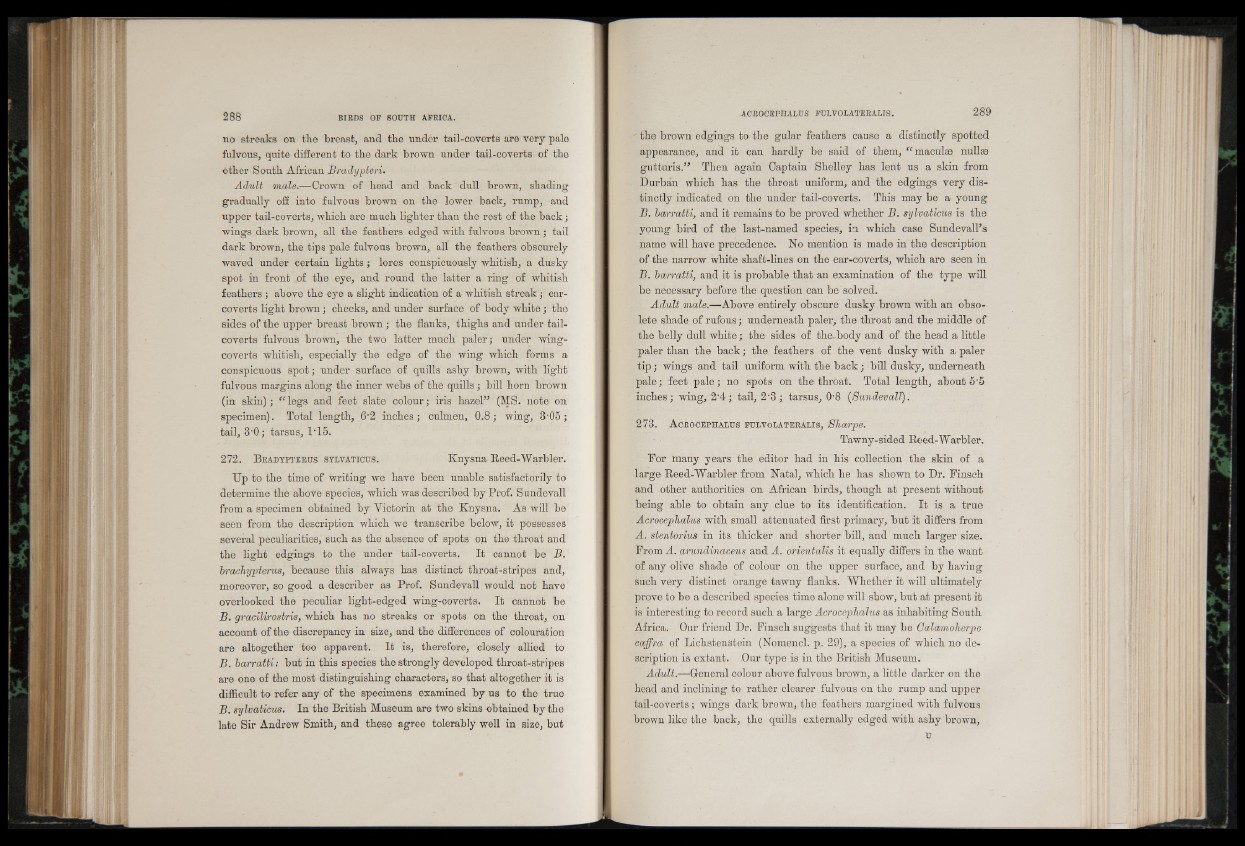
no streaks on the breast, and the under tail-coverts are very pale
fulvous, quite different to the dark brown under tail-coverts of the
other South African jBradypteri.
Adult male.—Crown of head and back dull brown, shading
gradually off into fulvous brown on the lower back, rump, and
upper tail-coverts, which are much lighter than the rest of the back;
wings dark brown, all the feathers edged with fulvous brown; tail
dark brown, the tips pale fulvous brown, all the feathers obscurely
waved under certain lights; lores conspicuously whitish, a dusky
spot in front of the eye, and round the latter a ring of whitish
feathers ; above the eye a slight indication of a whitish streak; ear-
coverts light brown; cheeks, and under surface of body white; the
sides of the upper breast brown; the flanks, thighs and under tail-
coverts fulvous brown, the two latter much paler; under wing-
coverts whitish, especially the edge of the wing which forms a
conspicuous spot; under surface of quills ashy brown, with light
fulvous margins along the inner webs of the quills ; bill horn brown
(in skin); “ legs and feet slate colour; iris hazel” (MS. note on
specimen). Total length, 6‘2 inches; culmen, 0.8; wing, 3‘05;
tail, 3'0; tarsus, 1*15.
272. B eadypterus sylvaticus. Knysna Reed-Warbler.
Up to the time of writing we have been unable satisfactorily to
determine the above species, which was described by Prof. Sundevall
from a specimen obtained by Yictorin at the Knysna. As will be
seen from the description which we transcribe below, it possesses
several peculiarities, such as the absence of spots on the throat and
the light edgings to the under tail-coverts. It cannot be B.
brachypterus, because this always has distinct throat-stripes and,
moreover, so good a describer as Prof. Sundevall would not have
overlooked the peculiar light-edged wing-coverts. It cannot be
B. graciUrostris, which has no streaks or spots on the throat, on
account of the discrepancy in size, and the differences of colouration
are altogether too apparent. It is, therefore, closely allied to
B. barratti: but in this species the strongly developed throat-stripes
are one of the most distinguishing characters, so that altogether it is
difficult to refer any of the specimens examined by us to the true
B. sylvaticus. In the British Museum are two skins obtained by the
late Sir Andrew Smith, and these agree tolerably well in size, but
' the brown edgings to the gular feathers cause a distinctly spotted
appearance, and it can hardly be said of them, “ maculae nullse
gutturis.” Then again Captain Shelley has lent us a skin from
Durban which has the throat uniform, and the edgings very distinctly
indicated on the under tail-coverts. This may be a young
B. barratti, and it remains to be proved whether B. sylvaticus is the
young bird of the last-named species, in which case Sundevall’s
name will have precedence. No mention is made in the description
of the narrow white shaft-lines on the ear-coverts, which are seen in
B. barratti, and it is probable that an examination of the type will
be necessary before the question can be solved.
Adult male.—Above entirely obscure dusky brown with an obsolete
shade of rufous; underneath paler, the throat and the middle of
the belly dull white; the sides of the.body and of the head a little
paler than the back; the feathers of the vent dusky with a paler
tip; wings and tail uniform with the back; bill dusky, underneath
pale; feet pale; no spots on the throat. Total length, about 5‘5
inches; wing, 2'4; tail, 2'3 ; tarsus, 0‘8 {Sundevall).
273. A crocephalus fulvolateral is, Sliarjpe.
Tawny-sided Heed-Warbler.
For many years the editor had in his collection the skin of a
large Reed-Warbler from Natal, which he has shown to Dr. Finsch
and other authorities on African birds, though at present without
being able to obtain any clue to its identification. It is a true
Acrocephalus with small attenuated first primary, but it differs from
A. stentorius in its thicker and shorter bill, and much larger size.
From A. arundinaceus and A. orientalis it equally differs in the want
of any olive shade of colour on the upper surface, and by having
Such very distinct orange tawny flanks. Whether it will ultimately
prove to be a described species time alone will show, but at present it
is interesting to record such a large Acrocephalus as inhabiting South
Africa. Our friend Dr. Finsch suggests that it may be Galamoherpe
caffra of Lichstenstein (Nomencl. p. 29), a species of which no description
is extant. Our type is in the British Museum.
Adult.—General colour above fulvous brown, a little darker on the
head and inclining to rather clearer fulvous on the rump and upper
tail-coverts ; wings dark brown, the feathers margined with fulvous
brown like the back, the quills externally edged with ashy brown,
u